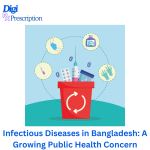
Bangladesh, a densely populated country, faces a significant burden of infectious diseases due to poor sanitation, climate change, urbanization, and inadequate healthcare infrastructure. From vector-borne diseases like dengue to waterborne illnesses like cholera, infectious diseases continue to pose serious health risks to millions of people. In this blog, we will discuss the most common infectious diseases in Bangladesh, their causes, symptoms, and prevention strategies.
1. Dengue Fever
Dengue fever is one of the most severe mosquito-borne diseases in Bangladesh, with outbreaks occurring every year, especially during the monsoon season.
Cause: Transmitted by Aedes mosquitoes.
Symptoms: High fever, severe body pain, nausea, vomiting, rash, and internal bleeding.
2023 Outbreak: Over 321,000 cases and 1,705 deaths recorded.
2024 Situation: Over 78,000 cases and 400+ deaths reported so far.
Prevention: Eliminate mosquito breeding sites, use mosquito repellents, and wear protective clothing.
???? Source: Reuters
2. Tuberculosis (TB)
Bangladesh is among the top 10 high-burden TB countries globally, making it one of the most significant infectious diseases in the country.
Cause: Mycobacterium tuberculosis, spread through the air.
Symptoms: Persistent cough, chest pain, weight loss, fever, and night sweats.
Annual Cases: More than 220,000 new TB infections reported.
Mortality Rate: 24 per 100,000 people.
Prevention: BCG vaccination, early detection, proper medication, and improved ventilation.
???? Source: Global TB Report, WHO
3. Cholera
Cholera is a major public health issue in Bangladesh, particularly in urban slums and flood-affected areas.
Cause: Vibrio cholerae bacteria, transmitted through contaminated food and water.
Symptoms: Severe watery diarrhea, dehydration, vomiting, and muscle cramps.
High-Risk Areas: Dhaka, Chattogram, and rural flood-prone regions.
Prevention: Access to clean drinking water, improved sanitation, and vaccination.
???? Source: ICDDR,B
4. Hepatitis B and C
Viral hepatitis is a silent epidemic in Bangladesh, often diagnosed at later stages.
Cause: Hepatitis B & C viruses, spread through blood and bodily fluids.
Symptoms: Fatigue, jaundice, abdominal pain, and liver failure.
Hepatitis B Prevalence: 3-5% of the population is infected.
Prevention: Hepatitis B vaccination, use of sterilized medical equipment, and safe blood transfusions.
???? Source: [Bangladesh Liver Foundation]
5. Typhoid Fever
Typhoid is a common bacterial infection in Bangladesh due to contaminated food and water.
Cause: Salmonella typhi bacteria.
Symptoms: High fever, weakness, stomach pain, constipation or diarrhea.
Outbreaks: Common during monsoons and in urban areas with poor sanitation.
Prevention: Drink safe water, practice good hygiene, and get vaccinated.
???? Source: [WHO Bangladesh]
6. Malaria
Although malaria cases have declined, some regions in Bangladesh, especially in the Chittagong Hill Tracts, remain high-risk areas.
Cause: Plasmodium parasites, transmitted by Anopheles mosquitoes.
Symptoms: Fever, chills, sweating, and headache.
High-Risk Areas: Bandarban, Rangamati, Khagrachhari.
Prevention: Mosquito nets, insect repellents, and antimalarial medication in endemic zones.
???? Source: [Bangladesh National Malaria Control Program]
7. Leptospirosis
Leptospirosis, also known as “rat fever,” is an emerging infectious disease in Bangladesh, particularly during floods.
Cause: Leptospira bacteria from contaminated water or animal urine.
Symptoms: Fever, chills, muscle pain, headache, and kidney failure in severe cases.
Outbreaks: Linked to flooding and exposure to contaminated water.
Prevention: Proper sanitation, protective clothing, and rodent control.
???? Source: ICDDR,B
8. Rabies
Rabies is a fatal disease in Bangladesh, primarily due to dog bites.
Cause: Rabies virus, transmitted through saliva of infected animals.
Symptoms: Fever, confusion, paralysis, hallucinations, and hydrophobia.
Annual Deaths: Over 2,000 deaths reported each year.
Prevention: Immediate wound washing, post-exposure vaccination, and controlling stray animals.
???? Source: [WHO Bangladesh]
9. Nipah Virus Infection
Nipah virus (NiV) is a highly fatal emerging disease in Bangladesh, often linked to contaminated date palm sap.
Cause: Nipah virus, transmitted from bats or infected animals.
Symptoms: Fever, vomiting, brain inflammation (encephalitis), coma, and death.
Fatality Rate: 40-75?pending on outbreak severity.
Outbreaks: Mainly in winter months due to raw date palm sap consumption.
Prevention: Avoid raw date palm sap, improve surveillance, and maintain hygiene.
???? Source: CDC Bangladesh
10. COVID-19 & Influenza
While the COVID-19 pandemic has decreased in severity, new variants continue to emerge. Influenza is also a seasonal concern in Bangladesh.
Cause: SARS-CoV-2 (COVID-19) and Influenza A/B viruses.
Symptoms: Fever, cough, sore throat, difficulty breathing, fatigue.
Preventive Measures: Vaccination, wearing masks in crowded places, and maintaining hygiene.
???? Source: WHO COVID-19 Bangladesh Updates
Conclusion
Infectious diseases remain a major public health challenge in Bangladesh. Rapid urbanization, climate change, and inadequate sanitation continue to contribute to disease outbreaks. Preventive measures such as vaccination, clean drinking water, mosquito control, and public awareness campaigns can significantly reduce the spread of these diseases. Strengthening the healthcare system and improving access to early diagnosis and treatment will be crucial in controlling infectious diseases in Bangladesh.
References:
WHO Bangladesh Health Data – WHO
Reuters Dengue Report – Reuters
ICDDR,B Cholera & Leptospirosis Reports – ICDDR,B
CDC Nipah Virus Information – CDC
Bangladesh Liver Foundation – Hepatitis Data
National Malaria Control Program – Bangladesh
